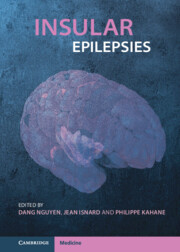Book contents
- Insular Epilepsies
- Insular Epilepsies
- Copyright page
- Contents
- Contributors
- Foreword
- Chapter 1 A Brief History of Insular Cortex Epilepsy
- Section 1 The Human Insula from an Epileptological Standpoint
- Section 2 The Spectrum of Epilepsies Involving the Insula
- Section 3 Noninvasive Investigation of Insular Epilepsy
- Chapter 13 Noninvasive Electrophysiological Investigations in Insular Epilepsy
- Chapter 14 Structural Imaging of Insular Epilepsy
- Chapter 15 PET and SPECT in Insular Epilepsy
- Chapter 16 Neuropsychology of Insular Epilepsy
- Section 4 Invasive Investigation of Insular Epilepsy
- Section 5 Surgical Management of Insular Epilepsy
- Index
- References
Chapter 13 - Noninvasive Electrophysiological Investigations in Insular Epilepsy
from Section 3 - Noninvasive Investigation of Insular Epilepsy
Published online by Cambridge University Press: 09 June 2022
- Insular Epilepsies
- Insular Epilepsies
- Copyright page
- Contents
- Contributors
- Foreword
- Chapter 1 A Brief History of Insular Cortex Epilepsy
- Section 1 The Human Insula from an Epileptological Standpoint
- Section 2 The Spectrum of Epilepsies Involving the Insula
- Section 3 Noninvasive Investigation of Insular Epilepsy
- Chapter 13 Noninvasive Electrophysiological Investigations in Insular Epilepsy
- Chapter 14 Structural Imaging of Insular Epilepsy
- Chapter 15 PET and SPECT in Insular Epilepsy
- Chapter 16 Neuropsychology of Insular Epilepsy
- Section 4 Invasive Investigation of Insular Epilepsy
- Section 5 Surgical Management of Insular Epilepsy
- Index
- References
Summary
The insular cortex is gaining attention in the epilepsy literature; however, characteristics of insular epilepsy on non-invasive electrophysiological studies are still being defined. In this chapter, we review this emerging literature with a focus on electroencephalography and present the ictal and interictal findings of 106 patients collected in the literature. Despite the location of the insula in the depth of the Sylvian fissure, a majority of patients have ictal and interictal epileptiform abnormalities on scalp EEG, which are most commonly found in the frontal or fronto-temporal electrodes. The distribution of these findings follows an antero-posterior gradient in keeping with the connectivity pathways of the insular cortex. Multifocal abnormalities are common in the pediatric population and should not preclude surgical evaluation. Evidence is increasingly favoring magnetoencephalography as a complementary modality to EEG and its use will likely be more prominent. Scarce data is available on the utility of high-density EEG, and more studies are thus needed.
- Type
- Chapter
- Information
- Insular Epilepsies , pp. 141 - 162Publisher: Cambridge University PressPrint publication year: 2022



